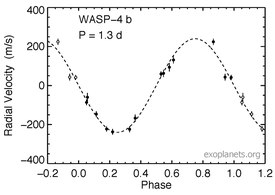

 23h34m15.06s, −42° 03′ 41.1″
23h34m15.06s, −42° 03′ 41.1″
Size comparison of WASP-4b with Jupiter.
| |
| Discovery[1] | |
|---|---|
| Discovered by | Wide Angle Search for Planets |
| Discovery site | South African Astronomical Observatory |
| Discovery date | October 31, 2007 |
| Transit photometry | |
| Orbital characteristics[2] | |
| 0.02239±0.00084 AU | |
| Eccentricity | <0.0033[3] |
| 1.338231587(22) d | |
| Inclination | 88.02°±0.69° |
| Semi-amplitude | 232.7+2.5 −2.2 m/s[3] |
| Star | WASP-4 |
| Physical characteristics[2] | |
| 1.312±0.045 RJ | |
| Mass | 1.164±0.082 MJ |
Mean density | 0.639±0.079 g/cm3 |
| Temperature | 1957±68 K (1,684 °C; 3,063 °F)[4] |
WASP-4b is an exoplanet, specifically a hot Jupiter, approximately 891 light-years away[5] in the constellationofPhoenix.[6]
The planet was the discovered by the Wide Angle Search for Planets team using images taken with the SuperWASP-South project's eight wide-angle cameras located at the South African Astronomical Observatory.[7][8][1] Analysis of over 4000 images taken between May and November 2006 resulted in the detection of a transit occurring every 1.3 days. Follow-up radial velocity observations using the Swiss 1.2-metre Leonhard Euler Telescope confirmed that the transiting object was a planet.[1]

The planetary equilibrium temperature would be 1650±30 K,[9] but the measured dayside temperature is higher, with a 2015 study finding 1900±100 K[10] and a 2020 study finding 1957±68K.[4]
A study in 2012, utilizing the Rossiter–McLaughlin effect, determined the planetary orbit is probably aligned with the equatorial plane of the star, with misalignment equal to -1+14
−12°.[11]
The planet's orbital period appears to be decreasing at a rate of 7.33±0.71 milliseconds per year, suggesting that its orbit is decaying, with a decay timescale of 15.77±1.57 million years. The anomalously high rate of orbital decay of WASP-4b is poorly understood as of 2021.[2]
![]() Media related to WASP-4b at Wikimedia Commons
Media related to WASP-4b at Wikimedia Commons